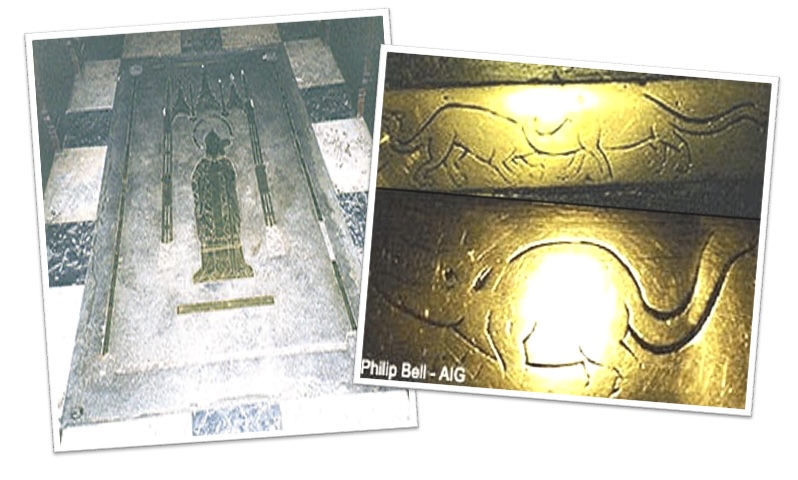Did Dinosaurs and People Ever Live Together?
The question for this first lesson is did dinosaurs and humans exists at the same time? The obvious implications of Scripture are that they did. But the question follows: "What evidence is there for their coexistence outside of the Bible?" You be the judge.
Based on the Bible's accountable creation and the flood we should expect that dinosaurs have been our contemporaries. We're continually told that dinosaurs went extinct millions of years ago. Since both claims cannot be true, I'm asking you to consider the following evidence for the relatively recent coexistence of dinosaurs with man.
Legends
Abounding in the histories of many peoples are accounts of lizard-like beasts, and the existence of such creatures has been recorded by explorers, historians, scholars, and even kings and saints.
Dragons
Prior to 1841 there was no word such as dinosaur. Sir Richard Owen coined the word dinosaur, which incidentally means terrible lizards. Before that time, dinosaurs would have been called dragons. Incidentally, though, dinosaurs is a cool word. I think dragons is cooler, but that's an argument for a different day. The issue is that accounts of dragons are abundant in the histories of many people, and that's what we're looking at.
Who has accounts of dragons?

China and Japan are two nations famous for their dragons and also their neighbor, Nepal, just to the west of China, is also a nation fraught with legends of dinosaur-like creatures or dragons. The Pacific Islanders have such accounts and so do those in Australia (the Aboriginal people there). The African tribes in a completely different continent. North American Indian tribes and South American cultures have accounts of dinosaur-like creatures. The ancient people of Egypt wrote about them. Ethiopia, Persia, India, Russia and Europe, but more specifically in Europe, England, France, Ireland, Switzerland, Scandinavia, Germany, Italy, Greece, all these nations, all these cultures, all of these peoples have legends of beasts that were either dinosaurs or very much like dinosaurs. It's abundant, it's prolific. It's all over the globe.
North American Tribes
Let's start in North America with the Native Americans that we know as the Ojibwa people. They had an animal they called the Unktehi. He's depicted here on Agawa Rock at Misshepezhieu, Lake Superior, provincial park in Ontario, Canada. And this animal was known to them, but also it was known to the Sioux of the Northern Plains.
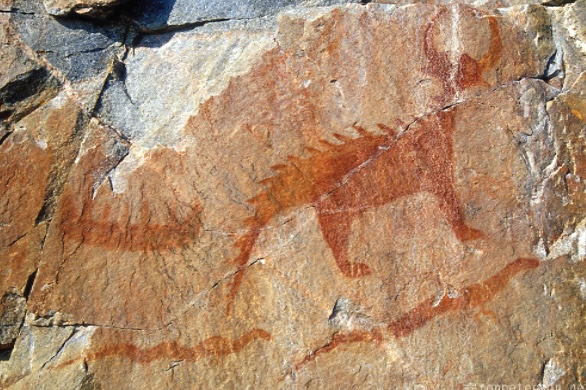
You see this depiction here, a large creature. If the scale is in any way accurate, that must be a canoe with about five warriors in it. And there's some pretty large snakes pictured there with it. But why in the world would they draw such a creature if they hadn't seen something like that? Henry Rowe Schoolcraft who was a geologist and an Indian agent wrote extensively about the Sioux Indians. He recorded images like the ones we saw the Ojibwa had made, as well as accounts of the creatures.
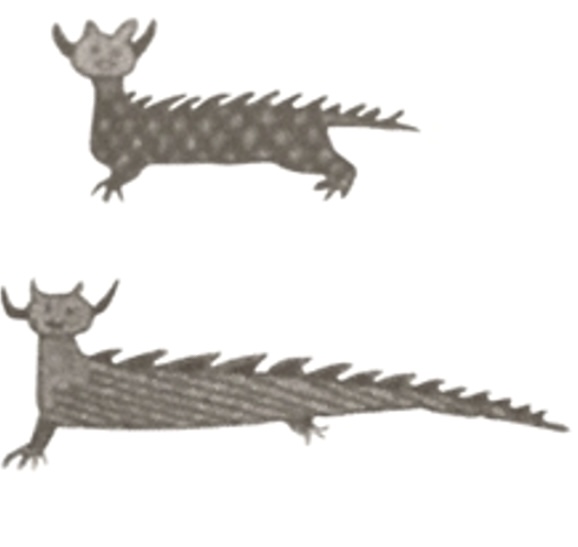
These two drawings are reproduced from about an 1850 set of pictures made by Sioux Indians on Birch Bark. And I want you to notice a similarity to this depiction of an Ankylosaurus. So again, we've got the Ojibwa Indians, we've got the Sioux Indians drawing similar pictures of creatures that must have existed. And those creatures, whatever they drew, were very much like an Ankylosaurus. Were they seeing an Ankylosaurus? How did the Ojibwa and Sioux make such accurate drawings if they had not seen one?
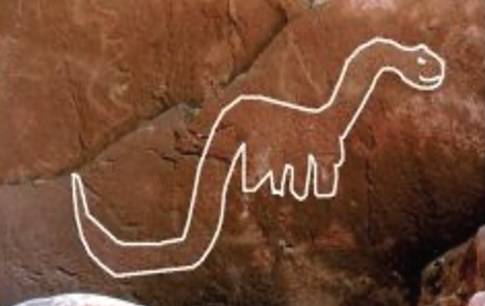
Further west from the Sioux, the Ojibwa were the Anasazi Indians. They left depictions, or at least this depiction of what appears to be a sauropod dinosaur. This carving was found near the Katrina Bridge and the Natural Bridge Monument of Utah and, also in this area, they found a picture of an Ibex and another picture that resembles a wooly mammoth. The remains of both of these animals, the Ibex and the mammoths, have been found in that region, though the animals themselves have not been present for many years, as far as we know. But also, the remains of sauropods have also been found. So if they drew the Ibex and we assume they saw the Ibex and they drew the mammoth and we assume they saw the mammoth, why would we not assume that they had seen the sauropod since they drew a sauropod? That's a question I think, worthy of consideration.

These drawings were perhaps from the Anasazi as well. At any rate, these are from New Mexico. This Petroglyph was discovered in 2012, near Hidden Mountain, just outside of Los Lunas, New Mexico. It's on an isolated, almost inaccessible ledge, and it is also near a very clear deer petroglyph. In other words, these folks were etching out pictures of animals that they had seen. We would naturally think they had seen a deer as the Anasazi would have seen an Ibex or a mammoth. And so when you see this depiction, we wonder what in the world is this? And surely they must have seen it along with the other creatures that they etched in stone. So was this ancient artist drawing a Saurolophus? That's what it looks like.
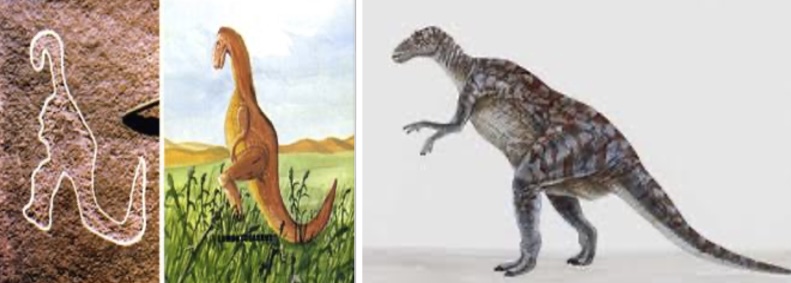
There are other dinosaurs similar to the Saurolophus that might have been, but they are very definitely dinosaur-like, if you will. And why would they draw such a picture? Why would they etch such a picture? Why would they go to the pains and the exert the energy to do this if they had not seen such an animal etched into the wall of the Grand Canyon that appears to be an Saurolophus? I mean, if you were going to make up a dinosaur, make up a creature, make up a fantastic animal to draw, would you draw that? But if you had seen one, on the other hand, why wouldn't you draw it? They seem to draw pictures of lots of animals that they encountered.
This etching was discovered by Samuel Hubbard who is an evolutionist. He discovered it in the late 1800s. And the etching itself is about 11 inches by nine inches. So how did the artist reproduce the image so accurately? Had he seen an Edmontosaurus? It certainly seems like he did to have gotten the picture so accurate. And fossil remains of those creatures have been found in the area. And it's interesting that Samuel Hubbard discovered this and he, being an evolutionist, had this to say:
"The fact that some prehistoric man made a pictograph of a dinosaur on the walls of this canyon upsets completely all of our theories regarding the antiquity of man. Facts are stubborn and immutable things. If theories do not square with the facts then the theories must change, the facts remain."
- Samuel Hubbard
Doheny, E. L., Discoveries Relating to Prehistoric Man by the Doheny Scientific Expedition in the Hava Supai Canyon Northern Arizona, 1924, p. 5.

Other Native American tribes have depicted dinosaurs in their pottery and in other artifacts. But this piece was left by the Mississippian culture, which would have dated about 800 to 5000 A.D. or Common Era, if you will. What animal could this piece of art represent, if not a Sauropod? The swirl on the picture, we're told most likely represents water. That makes sense to me and probably does to you as well. And we often associate Sauropod dinosaurs with water or creatures that live in or near the water. And perhaps that's exactly what this piece of pottery was depicting: a sauropod dinosaur with the image of water so that we could relate it to. That's where it lived.
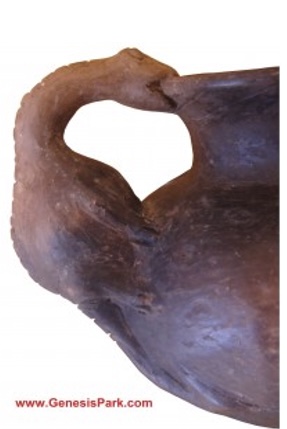
Here's another piece of pottery. This was made by the Mississippi Caddo Indians around 1200 A.D. Is that not an image of a dinosaur fashioned as a handle? Certainly looks like it to me. I don't know what else it could be, if not that. And the question is, how did early Native Americans know how to accurately depict such animals if they had not seen them? That's the question that keeps coming up.
Illini Indians
If you ever wondered where Illinois got its name, it must have been from the Illini, Indians. These native people tell a legend of a Piasa (bird) that devours man. This bird lived in a cave and it killed many people. Piasa was supposedly killed by a young man with a bow and arrow after the creature had killed his family.
Pima Indians
The Pima Indians of southern Arizona have a similar story coming from a report by Spanish explorer Captain Juan Mateo Manje, with Jesuits Eusebio Francisco Kino and Adamo Gil. By the way, notice that we've got the names of people, historic people, who had been sent out to do research and to explore. They're bringing us credible accounts about these Indian legends. The Pima people told these men of two great flying monsters that ate people very similar to the account by the Illini Indians on the other side of North America. One of these creatures was asphyxiated when the Indians built a fire at the mouth of its cave and the other was killed in a similar fashion after it had inhabited a pueblo. The Yaqui Indians of Southern Arizona also have a similar account.
So we've got the Pima Indians, the Yaqui Indians and the Illini Indians all having accounts and stories about these great flying creatures that ate people with which they had to contend. Interesting. You have to wonder, did they see a Quetzalcoatlus, the largest Pterosaur?
Is it nothing more than mere coincidence that they would fabricate these stories? That they got spread around, that they just happen to make up a story about a creature whose remains are found in those areas?
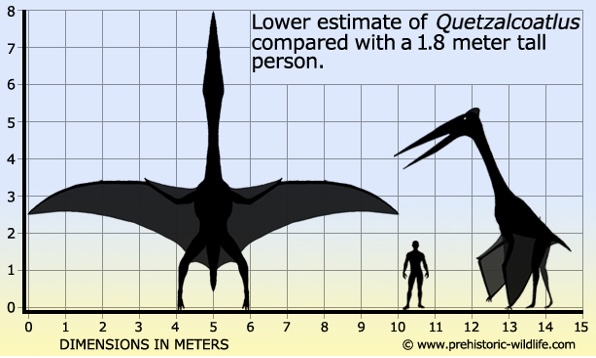
Take a look at that chart and see the size of that creature. That animal existed. We know it existed and it's very much like what they describe and could have easily been the animal that they were talking about.

Here are some figurines, many of which have been discovered. 33,000 of them have been discovered and about 2,600 of them are dinosaur-like creatures. These were discovered in 1945 by Waldemar Julsrud in a place called Acambaro, Mexico. Many people have tried to discredit their authenticity, but their attempts to discredit them have failed. So how did the people in Mexico know how to accurately depict these dinosaur figures? How did they know what dinosaurs looked like and how they would pose themselves? But there are 2600 dinosaur-like figurines in Acambaro, Mexico that have been unearthed. That's a lot of them.
Some of these figurines have dermal spines with their tails held aloft. These are details about dinosaur anatomy and posture that we did not know until the late 20th century. And yet whoever had buried these by 1945 and probably long before 1945 knew exactly what these creatures looked like and depicted them with dermal spines and their heads and tails held aloft.

Here's an Ica Ceremonial Burial Stone found in Peru from the Nasca culture from about 100 BC to 1800 AD. These stones (and there are a bunch of them) have many dinosaurs depicted on them. If you'll take a look at this one, it looks like there's a man riding on top of a sauropod dinosaur trying to kill it with a spear. While there are a couple of other dinosaurs, one above his head and one behind his back who are attacking him. Interesting that they were able to draw these animals so accurately to etch them into this stone.
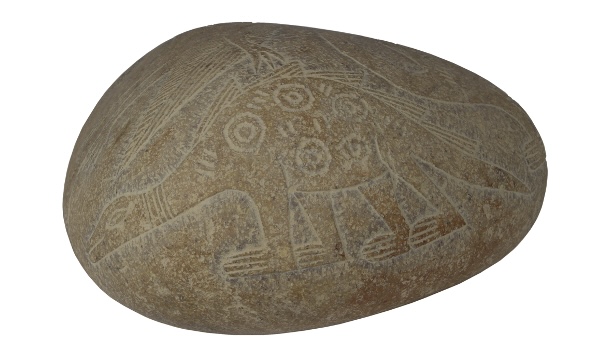
These stones also depict dermal spines. And we didn't know that dermal spines existed on dinosaurs until late in the 20th century.
"Another Discovery of dermal spines reveals a new look for sauropod dinosaurs"
- Czerkas, Stephen, Geology, vol. 20, Issue 12, p.1068, 1992
That wasn't about the stones, but the stones were telling the story before this had been put into this article.
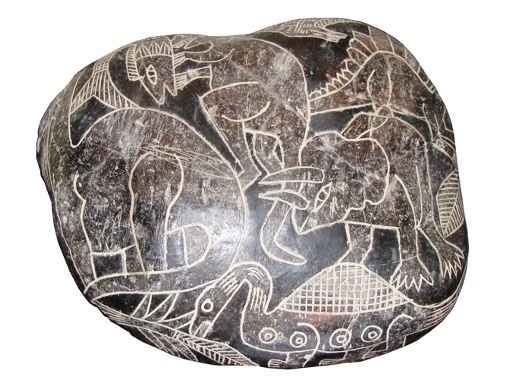
There's about 11,000 such stones that exist. There are some places where you could go look at them and put your hands on them. They picture a wide variety of dinosaurs as this stone does. How many dinosaurs can you count? Most sixth graders could probably name a bunch of what looks like a Triceratops, Dimetrodon or Sauropod dinosaur, maybe and Apatosaurus or a Brachiosaurus. Who knows? How did they know how to etch these animals so accurately? That's the question we keep coming back to for all these people all over the world:
How did people in ancient times make pictures of dinosaurs with such accuracy and detail?
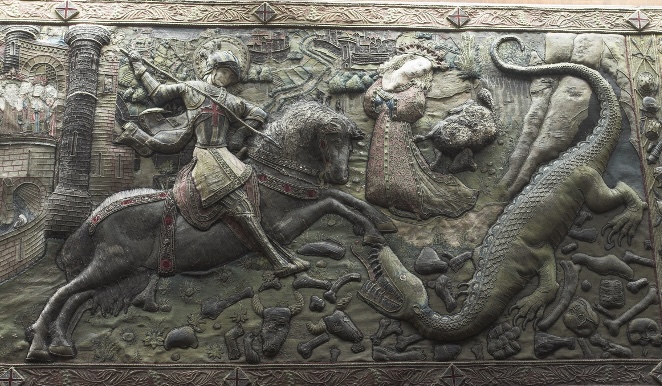
Have you heard of St. George killing the Dragon? It's a story that's been relegated to myth and legend, but nearly all ancient depictions show the dragon the same size as him. Which to me is significant. If you were making up a story about somebody killing a dragon, wouldn't you make the dragon big and tall and really fearsome? But instead, you've got this animal that looks like kind of a glorified crocodile. I think if I was going to make up a dragon, I could do a better job than that. And yet the early depictions of the dragon that St. George killed are all very much like this one here.
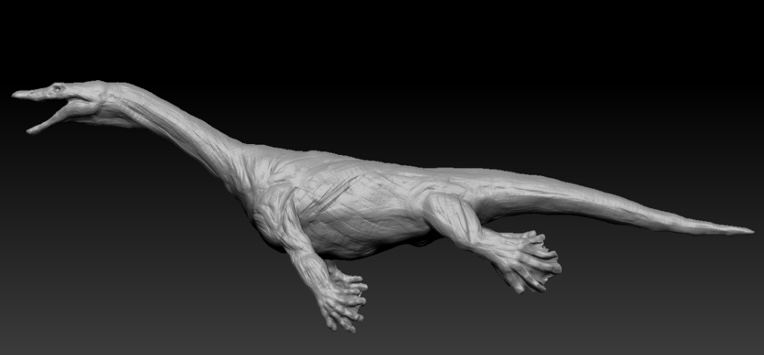
Early depictions show creatures similar to this guy who was a Nothosaurus whose fossils are found in the area where St. George is said to have killed the dragon. Isn't that interesting? So we've got this animal with fossilized remains in a place where George killed the dragon.
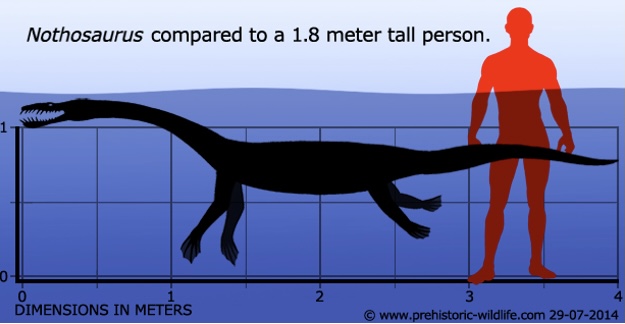
This chart is showing about what an adult would have looked like compared to a Nothosaurus, which is, interestingly enough, about what is pictured in the early depictions of George killing the Dragon. Not some great tall, giant beast, but this animal who actually did live in that area looks about right. When you look at the scale, you take a look at the size of an animal as compared to the drawing of the man. And then you look at George there on his horse and there's the dragon, there's the damsel he's rescuing. It's not just a great story. It appears to be history. And there is a great deal of evidence to support that.
English Dragons
You see in this picture on the tomb of Bishop Richard Bill, depictions on brass inlays of all kinds of creatures: a dog, a pig, a weasel, and other such animals. But in addition to these normal animals, we have depictions of what appear to be two sauropods and then another crocodilian-shaped dinosaur. And he was laid to rest in 1496. So these engravings on his tomb are from 1496. How did they know to depict these animals so accurately? It's very interesting. How did the engravers know how to accurately depict Sauropods both anatomically and according to their posture, which we've not understood until recently to be with heads and tails held aloft and held horizontal only. But they knew that, and that's how they put them in that brass.
British Dragons
There's a lady by the name of Jacqueline Simpson, and she mentioned in her book British Dragons, which she wrote in 1980 that over 70 villages in Great Britain have legends and traditions involving local dragons. Where would all that information come from? If there wasn't something to it, that's the question.

Here are a couple of depictions in a French chateau from the Middle Ages, about the 1500s. They're decorated with salamanders. These are creatures that they say breathed fire and these carvings are abundant. They're all over the chateaux in France.
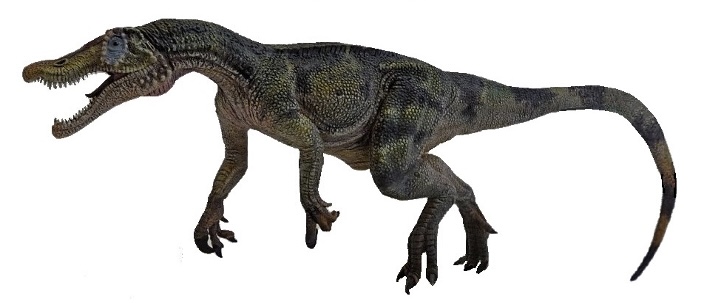
And in that same area, we see the remains of this fella, Baryonyx. His remains are found throughout Europe. Is it just a coincidence? And it's interesting that they put these pictures on their chateaux to protect their chateaux from fire because this creature, they said, breathed fire itself. And so with the idea of putting the fire-breathing creature on their homes, on their chateaux, they were protecting them from fire. That's what they believed. Why would they believe that? And how could they depict this animal so accurately if they hadn't seen one?
Mesopotamia (Iraq, Iran, Syria, Turkey)

This area has produced this artifact. It's a four-cylinder seal from the Uruk period, which is about 3500 B.C. in Mesopotamia. It's currently housed at the Louvre in Paris. These are artifacts that are in existence. They've not been imagined or created or made up. They really exist and they depict these animals accurately. There's a striking similarity between the beasts that are depicted on that seal and in Apatosaurus, (you can see an artist's conception of an Apatosaurus right there). So, are we just supposed to believe that this is all coincidence that the artist guessed right? You remember there was an Apatosaurus etched on the wall of the Grand Canyon in Arizona and now we've got them here on the other side of the world. We have them engraved on tubes in England. They're all over the place. How did people in so many different places at so many different times know how to accurately depict these same creatures? It's a question worth considering.

This time we have dragons from Israel. And what in the world are these dinosaur-like creatures depicted on this ancient synagogue in the Umm El-Kanatir district, on the archaeological site called Golan Heights. How did the artists know? We keep coming back to that question. Why would they make such creatures if they were simply fanciful? And how would they depict them accurately to what we know dinosaurs did look like?
Dragons figure prominently in Jewish scripture
- The "leviathan" mentioned in Job 3:8, Psalms 104:26 and Isaiah 27:1
- The flying serpents of Isaiah 14:29 and Isaiah 30:6
- Behemoth, from Job 40 in detail having a tree that's a tail that swings like a cedar great and bones like bronze. He's not afraid of the floods reminiscent of that pottery piece that the Mississippi Caddo Indians made with the sauropod looking dinosaur in the swirling of water.
- The great dragon of the Revelation, Revelation 12:9
Chinese dragons
It seems everybody knows about Chinese dragons. China is proliferated with dragon legends. Is it simply coincidence that China has so many legends, but also has so many dinosaur fossils? Probably not.
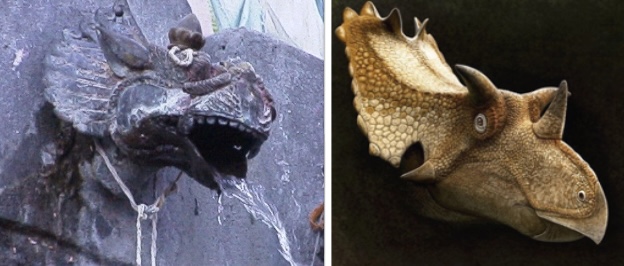
The Muktinath Temple in Nepal boasts 108 dragon head fountains. We have to ask again, is it just a coincidence that this one looks just like a Ceratopsian dinosaur? How would they know to make this unless they had seen one?
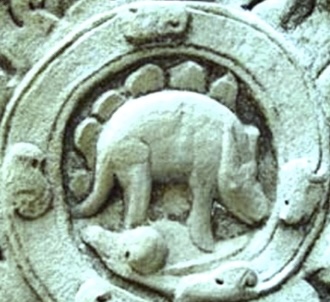
Here is one that is from Cambodia which is not too far from Nepal and China. What's that creature look like carved into that stone? Doesn't it look like a a Stegosaurus? Any sixth grader would say, "Oh yeah, that's a Stegosaurus." This piece of art is in an 800-year-old Ta Prohm Temple in Cambodia. The carving is just one of many others depicting monkeys, deer, buffalo, lizards, parrots, and animals that they would have seen on a daily or on a regular basis. And along with those animals, they depicted this one, which indicates they saw it on a regular basis as well. So how could they have known what a stegosaurus looked like unless they had seen one? They had to have seen one. Just like in all these other instances of people recreating images of dinosaurs, how could they have done that without having seen those animals?
Summary
So what have we seen? We have ancient peoples over thousands of years from multiple cultures, on several continents, in varied mediums. In other words, they etched them. They used pottery to depict dinosaurs, they used statuary, they painted them, they engraved them, they carved them, they put them in their literature. All these different methods and more. They used to communicate the fact that they had seen and had experience with dinosaurs or dinosaur-like creatures, and they did it all with accurate detail. The depictions of dinosaurs were repeated. How could that be possible in so many places and so many times and in so many ways? If they had not actually seen these great beasts?
So which conclusion makes more sense? Ancient peoples accidentally created accurate images of creatures long extinct, or they saw the creatures and recreated what they saw.
But hold on. We haven't come to the end of it yet. Soft tissue inside a T-Rex fossil. Could it be possible? Paleontologist Mary Schweitzer and her team were surprised to find soft tissues inside the femur bone of a T-Rex they discovered in Montana.
For more than a century, the study of dinosaurs has been limited to fossilized bones. Now, researchers have recovered 70 million-year-old soft tissue, including what may be blood vessels and cells, from a Tyrannosaurus rex.
- Scientists recover T. rex soft tissue
NBCNews.com, March 2005
Schweitzer said that after removing the minerals from the specimen, the remaining tissues were soft and transparent and could be manipulated with instruments and that the bone matrix was stretchy and flexible. She said also there were long structures like blood vessels. What appeared to be individual cells were visible. Here's what one of the scientists, John Horder from the Museum of the Rockies at Montana State University, said about the discovery. It is "a fantastic specimen," but probably not unique. Other researchers might find similarly preserved soft tissues if they were to split open the bones that were in their collections.
But I imagine most of them are reluctant to do that. Nevertheless, this guy is saying it's probably not that unique. So are we really being asked to believe that stretchy, flexible, transparent tissues from a T-Rex have survived 70 million years without disintegrating? How would they survive 70,000 years? Can you even imagine 70,000 years? Much less 70 million years? Can you even imagine 7,000 years? Just 7,000 years? How would they last 7,000 years? But we're not talking 7,000. We're not even talking 70,000. We're being asked to believe that these tissues have survived as stretchy, flexible and transparent for 70 million years, and they have not disintegrated or fossilized. What science is there that would provide a definitive explanation for that kind of preservation? There isn't one.
So which demands more faith regarding this particular find that these tissues that are stretchy, flexible and transparent really are 70 million years old, or that there is a more recent age for these remains? You have to draw that conclusion for yourself.
We have been told over and over again that dinosaurs became extinct millions of years ago. We've been told that with such consistency and fervor, such dogmatism, that we've come to accept it as science. But what does the word science mean? The word means knowledge. And what do we really know? What we know, what is real science is that the abundance of evidence regarding the recent existence of dinosaurs leads us to conclude that a time frame of millions of years simply does not fit what we see.
That's real science. That's real knowledge.




